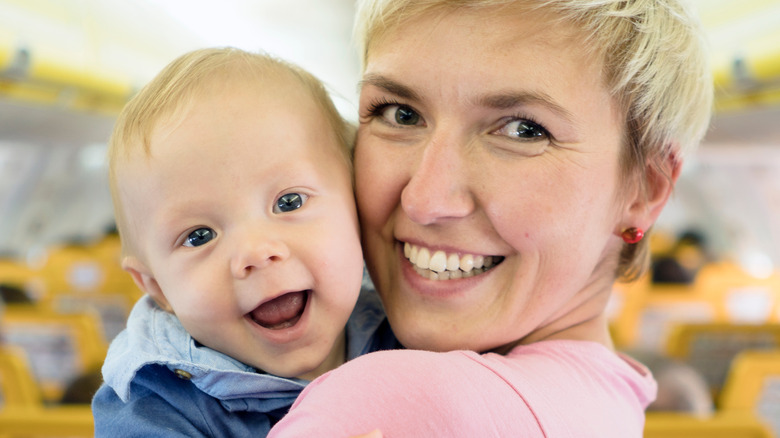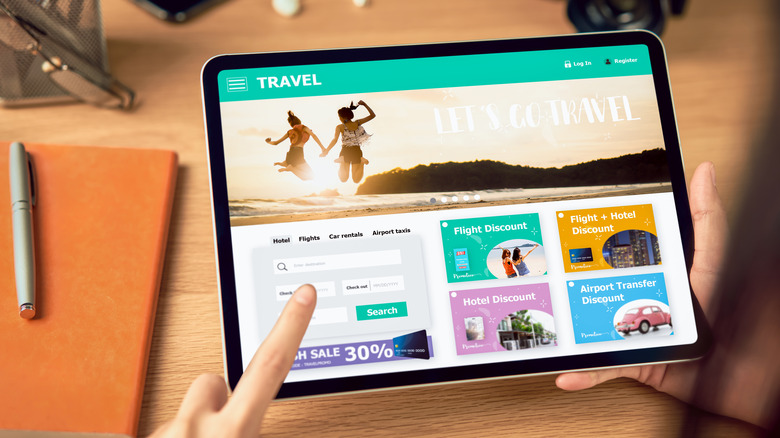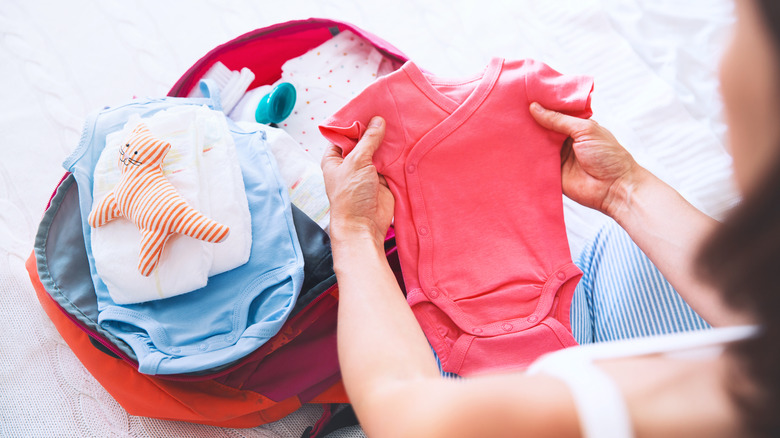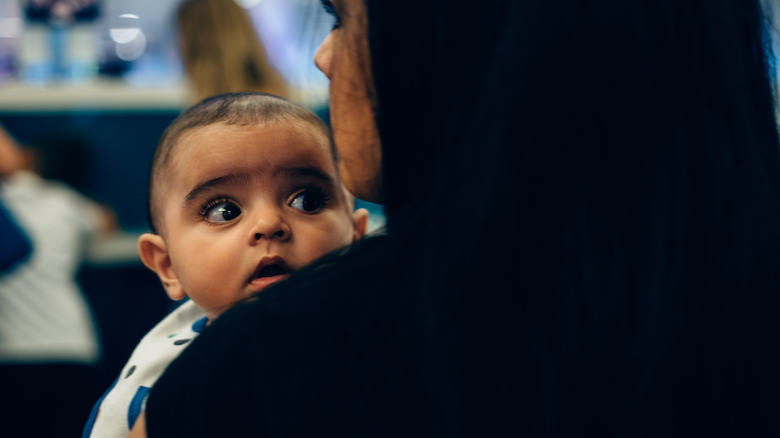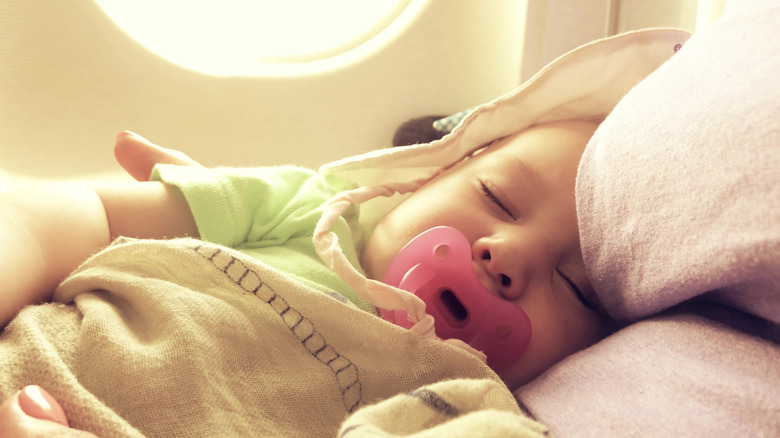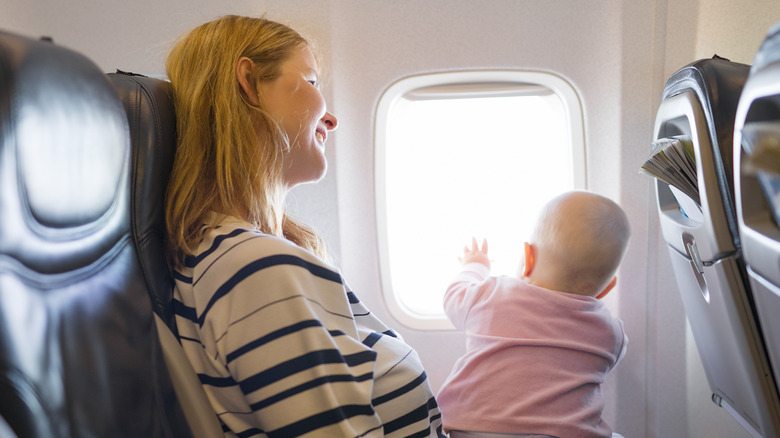Tried And True Tips For A Stress-Free Flight With Your Baby
Bringing a baby — i.e., infants aged 0 to 1 year — along on a flight can be challenging. You might forget to pack or carry on some things or be ill-prepared to handle the situation in the airport or on board. Then stress enters the picture, and things spiral out of control. It can be too much for any parent to bear.
The usual culprit on a stressful flight is a lack of preparation because as Shelly Rivoli, author of "Travels with Baby: The Ultimate Guide for Planning Trips with Babies, Toddlers and Preschool-Age Children," told Parenting: "Babies can be surprisingly good travelers. The major advantage is that they're not very mobile yet."
So, with proper knowledge and good preparation, sprinkled with the right mindset and some room for flexibility, taking a baby on a domestic or international flight can be devoid of unnecessary problems and stress. Here are 12 tips on how you should prepare for the flight and what you can do once on board.
Booking your flight
First, book a flight around your baby's sleep routine. This could mean booking a flight that departs near their naptime or bedtime so they can just sleep throughout or most of the flight. On long flights, you could consider booking a red eye so your baby can get a more peaceful and restful sleep.
Second, book a bulkhead seat if you can. While seat selection might come with an extra charge, it beats getting seated in a tough spot on the plane. Booking a bulkhead seat during a long flight, for instance, not only provides you with more legroom but also allows you to easily access the bassinet (request and confirm with your airline). If you'll be nursing your baby during the flight, check out The Points Guy's guide to the best business-class seats on U.S. airlines that offer privacy or the least amount of distractions.
Third, book a non-stop flight. Though you'll have to pay more, a non-stop flight means you will only have to deal with boarding once. If this is not possible, then pick an itinerary with a longer layover period so you don't have to rush to your next flight after deplaning.
Pre-flight planning: How to prepare for an upcoming flight with a baby
Tip No. 4 is to use a checklist. Planning is essential when flying with a baby, and a checklist will help you keep track of everything you need to do or pack for the flight. "Create a checklist — or even better, a Google document — and share it with your partner; then keep updating it over time," Spriha Srivastava, deputy digital news editor for CNBC International, advises. You can copy or be inspired by this Google doc that Srivastava used as her very first checklist.
Tip No. 5 is to pack light but smart. Your baby will need many things, but be thoughtful about what you must bring and what you can buy or rent at the airport and your destination, such as diapers and formula. Depending on your destination, you can rent a car seat, crib, etc. from rental companies such as Babys Away and Rent It Today and have them delivered to your hotel. Bring only the essentials with you in your carry-on or diaper bag, including pacifiers, diapers, changing pads, baby wipes, plastic bags, and extra clothes. If your baby is taking any medications, be sure to fill their prescriptions before flying, in case those medications aren't available where you're going. In addition, if your baby needs any documentation for the flight, e.g., a birth certificate, passport, or travel visa, be sure to keep it handy in your carry-on.
Note that if you're planning on bringing breast milk or baby formula, you'll have to inform the TSA and remove them from your carry-on to be screened. The same goes for baby food, which you can bring onboard in "reasonable quantities."
Maneuvering the airport with a baby
Tip No. 6 is to travel with a car seat or child carrier. Most airlines will allow you to check in a stroller and/or a car seat at the ticket counter or gate. For infant car seats, just make sure it's FAA-approved. The best ones to get are those car seats-cum-stroller like Doona or a light travel stroller that can be stored in the overhead compartment. If traveling alone with an infant, a carrier will leave your hands free to handle the luggage.
Tip No. 7 is to dress the baby in easy-to-wear and take off layers. This will keep them comfortable throughout the journey. You'll appreciate this when you're not struggling to change their diaper through difficult clothing. You can even bring a blanket in case the plane temperature gets too cold for them.
Tip No. 8 is to get to the airport early. Airlines allow families traveling with an infant to board ahead of other passengers, but you'll need to be at the airport at least 30 minutes before boarding time. Arriving early at the airport will also give you ample time to go through the boarding process after grabbing a bite or doing a last-minute diaper change for your baby.
Flying with a baby: What to do onboard the plane to keep stress levels at a minimum
Tip No. 9 is to make take-off and landing comfortable for the baby. Changes in cabin pressure can make our ears pop during take-off and landing, and this can be uncomfortable or even painful. Nursing, feeding, or giving your baby a pacifier during these times can help soothe the pressure.
Tip No. 10 is sanitize, sanitize, sanitize. Airplanes are just like any other public space where you and your baby can be exposed to germs. And, because "an infant's immune system doesn't mature until they're about two to three months old," pediatrician Camille Sabella, M.D., told Cleveland Clinic, it's important to wash your hands or use sanitizer often to lessen their exposure to germs.
Tip No. 11 is to prioritize sleep. This applies to both you and the baby. If you have a bulkhead seat, you can use the airline-provided bassinet. If not, you can strap them into their FAA-approved child restraint system (CRS), such as an infant car seat. If you're flying international, ask your airline if they have a sleeper seat option. A sleeper seat is composed of three seats in a row that can be interlocked to become a big sleeper. Or, ask the airline if you can use an inflatable seat extension — if that's something you're comfortable with using. Don't forget to bring your baby's favorite blanket, stuffed animal, or pacifier if that helps them sleep faster and more peacefully.
Once your baby is asleep, you should get some beauty sleep too. You'll need to recharge so you can handle the baby's needs and demands when they're awake.
Keep the proper mindset
Finally, tip No. 12 is to stay calm and keep flying. Remember that the flight is just a small part of your holiday with your baby — don't let it set the tone for your vacation. Life always finds ways to mess us up if we let it, so don't let your emotions get the better of you. Remain calm and plan to be flexible because things won't always turn out the way we want. Focus on making memories and laugh about the mishaps.
And if you need any help, don't hesitate to ask people. For instance, ask a fellow passenger to help you store your carry-ons in the overhead bin for you or request help from crew members. If you're traveling solo and require assistance at the airport, you can try Sky Squad, which offers a personal airport assistant — basically an extra pair of hands — to help you breeze through the airport to your plane. Pricing starts at $49 per hour.
